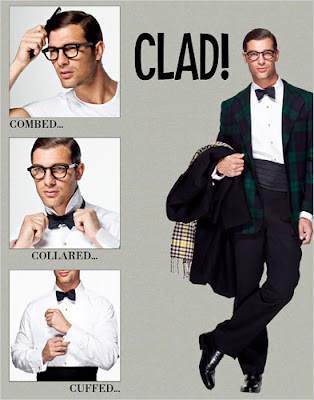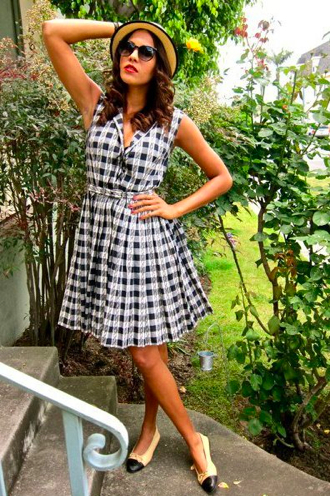But an overlooked aspect of “Mad Men” is the fashion turnabout it represents. In the show, the older men — Don Draper and his boss, Roger Sterling — are the best-dressed characters, while the new-kid, cool-cat copywriters are so loath to play the game that they won’t even wear a tie. Soon enough, the hippie movement would deride the necktie as a “dog collar” and any corporate-minded spoilsport as a “suit.” In the decades that followed, a minor genre of films addressed the Unsuiting of Mr. X, from “Barefoot in the Park” (1967) and “Easy Rider” (1969) to “After Hours” (1985) and “Something Wild” (1986).
Now the tie is on the other neck. Today the well-off 55-year-old is likely to be the worst-dressed man in the room, wearing a saggy T-shirt and jeans. The cash-poor 25-year-old is in a natty sport coat and skinny tie bought at Topman for a song. Young men are embracing the “Mad Men” elements of style in a way that the older men never did, still don’t and just won’t. The result is a kind of rift emerging between the generation of men in their 20s and 30s and those in their late 40s and 50s for whom a suit was not merely square but cubed, and caring about how one looked was effeminate.
The evidence of this style gap is everywhere. Just check out the numerous men’s wear blogs — acontinuouslean.com,dandyism.net, thetrad.blogspot.com,fineanddandyshop.blogspot.com — dedicated not to cutting-edge European fashion but to old-school minutiae of dressing well. Or take a look at the Cincinnati Bengals linebacker Dhani Jones, who favors double-breasted suits and bow ties and talks about “the resurgence of the gentleman.”
The trend reaches from Madison Avenue to the shopping mall. At Paul Stuart, most of the store’s growth is in its trim-tailored, dandified (and expensive) Phineas Cole line, courtesy of customers in their 20’s and 30’s, said Michael Ostrove, the store’s executive vice president.
Brooks Brothers, which has struggled since the 1980s to recapture the all-American style mantle that Ralph Lauren made off with, has received quite a bump from “Mad Men.” The company made the suits the main characters wear, to the specs of the costume designer, Janie Bryant.
And at Topman, the men’s branch of the popular Topshop, the category it calls “smart” clothing — dressier togs that straddle work and play — has been one of the best performers in its new New York store.
“I think it’s a reaction against the homogeneity of casual wear,” said Gordon Richardson, the design director of Topman. “There’s nowhere to go with that in terms of personality, whereas a suit sets you apart. And now there are suits that are cut for young people. There’s never been that before, so it’s new to them.”
In a twist, neckties are being sold at the very place that did more than any other to usher in casual Friday: Gap. Not to be outdone, American Apparel now sells bow ties.
“The older generation, say 45-plus, look upon success as being able to dress down,” said Marshal Cohen, the chief analyst at NPD Group, which tracks retail sales. “They think being able to wear jeans is the epitome of achievement.
“But the younger generation is looking at getting dressed up and making their mark,” Mr. Cohen continued. “It’s a real generation gap here. I teach at three different colleges, and I am amazed how dressed up some of the students are. Girls still come in their hoodies and pajamas, but boys come in their suits.”
NPD figures for the year ending Nov. 1 indicate that sales of tailored clothing among men ages 35 to 54 were down 17 percent. Among men ages 25 to 34, sales were up almost 4 percent.
“It’s these young guys rebelling against their boomer dads,” said Russell Smith, 45, the author of “Men’s Style: The Thinking Man’s Guide to Dress” and an advice columnist for The Globe and Mail in Toronto. “But it’s very amusing and paradoxical that the new anti-parental paradigm involves a pinstripe suit and a pocket square.”
Far from being a superficial movement, the style gap is seen by young men as something of real substance, with the same kind of opposition to fuddy-duddy ways that the boomers wore threadbare. A perfect (and hilarious) example of the tension is found in the newTracy Letts play “Superior Donuts,” in which an aging boomer gets a dressing-down (and a wake-up call) from his savvy young employee.
When the older man, Arthur, says, “I haven’t dated in a long time,” the young Franco deadpans, “That’s hard to believe, the way you dress and everything.” Voicing the watchwords of his generation, Arthur retorts, “I like to be comfortable.” Franco is unmoved: “You might be comfortable naked, but that don’t mean it looks good.”
And the new USA television show “White Collar” uses the style gap to breathe new life into the odd-couple buddy-cop formula: one sharp, the other flat. In the pilot, the show’s youthful con artist hero, Neal Caffrey, cajoles his way out of prison and into an elderly widow’s mansion and, more important, her late husband’s pristine early ’60s wardrobe. The shlubby and overworked F.B.I. agent to whom he is assigned is appalled.
“You look like a cartoon!” he says.
“This is classic Rat Pack,” Caffrey responds, adjusting his fedora. “This is Sy Devore!”
Like Barney Stinson, the well-dressed womanizer who constantly scoffs at his sloppily dressed friends on “How I Met Your Mother” on CBS, Caffrey is a truer reflection of the younger generation’s take on style than the whole cast of “Mad Men,” however perfectly turned-out they all are. For Caffrey, as for most young men today, dressing in a suit and tie is not just a choice but a stance that challenges the apathy and monotony of casual Friday culture.
“The fashion gene skipped a generation,” said Samuel Rascoff, 36, a law professor at New York University who specializes in national security law and who, being a fastidious dresser, has given serious thought to the trend, which he sees reflected in his students.
“There’s a sense that this return to style, or to a consciousness of how you look, is an attempt by young men to recover a set of values that were at one point very much present in American society and then lost,” he said. “It strikes me as being of a piece with the way young people buy their coffee or their food: paying attention to authenticity or quality, and to whether something is organic or local. They stand for a rejection of the idea that all consumer goods are ephemeral and inevitably made in China and bought at Wal-Mart.”
Baby boomers may well dismiss the trend as a silly phase that young men will soon outgrow, but they might consider how they are perceived in comparison.
“Not only do I see these guys out there, but I get agitated letters from their wives,” said Mr. Smith, the advice columnist. “One of the most frequent letters I get is: ‘My husband has moved up in his career, but he’s still dressing like a kid. I am embarrassed for him whenever he leaves the house. What do I do?’ I don’t get those letters from women in their 20s and 30s.”
So, in an age of irony, here’s a whopper: Given how zealously baby boomers have clung to, or hopped on, all kinds of youth trends, no matter how age-inappropriate, why can’t they hop on this one?
What’s the worst that could happen, Pops? Someone might think you are 10 years younger?
– THE NEW YORK TIMES By: David Colman









0 comments ↓
There are no comments yet...Kick things off by filling out the form below.
Leave a Comment